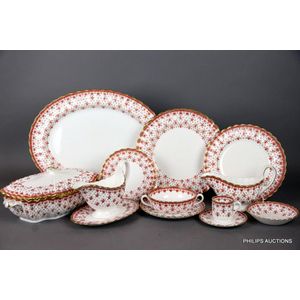Spode Red Fleur De Lys Dinner Set
You must be a subscriber, and be logged in to view price and dealer details.
Subscribe Now to view actual auction price for this item
When you subscribe, you have the option of setting the currency in which to display prices to $Au, $US, $NZ or Stg.
- Bone China - Bone china, Also called 'English china", is one of the three types of porcelain, the other two being soft paste porcelain and hard paste porcelain.
Porcelain is an ancient ceramic material, first made in China, hence the common name "china", and the introduction of bone china was to counter the imports of Chinese porcelain.
The initial development of bone china is credited to Josiah Spode, who introduced it around 1800 and it was soon after copied by other manufacturers including Minton, Coalport, Davenport, Derby, Worcester, Wedgwood and Rockingham and the Herculaneum factory at Liverpool.
Spode's bone china was made by mixing ash from cattle bones with feldspar and kaolin, which created a material that was stronger, more translucent, and whiter than traditional porcelain. He began to produce this new type of porcelain in 1796 and it quickly became very popular.
At the time, the process and ingredients were kept secret and were only known to a few manufacturers and were protected by patents.
In the 19th century, bone china became increasingly popular and was widely produced by many manufacturers in England. During this time, it was considered a luxury item and was often used to create fine dining sets and other decorative items.
Bone china is still used in the production of fine porcelain wares, such as tea sets, figurines, and other decorative pieces. His basic formula of six parts bone ash, four parts china stone, and three and a half parts china clay remains the standard English body. It is still considered a luxury item due to its strength, translucency, and whiteness, and is often used for high-end and high-quality porcelain. China. - Coffee Can - A coffee can is a cup for holding coffee, but of a cylindrical shape rather than the waisted shape of traditional cups. They were in use at the end of the 18th century and in the early 19th century.
This item has been included into following indexes:
- Copeland Spode (England), item types
- Copeland Spode (England), patterns - Fleur de Lys pattern 11
Visually similar items

South sea pearl and diamond ring, of cluster design centring a bouton-shaped cultured pearl measuring approximately 12.90 x 11.10 mm above an undulating open work surround accented by baguette and single-cut diamonds, the diamonds together weighing approxi

An American sterling silver oval table dish, with a beautifully pierced border, engraved with monogram, by Black Starr & Frost, New York. 248gms. Length 30 cm.

A pink tourmaline and diamond ring, centrally set with an oval cut rubellite of 3.03cts, surrounded by round brilliant cut diamonds totalling 0.43cts, mounted in 18ct rose gold, ring size L

A jade bead necklace; 14 mm round carved beads in green and pink tones. Length 75 cm.
